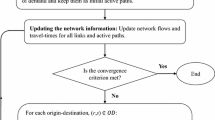Abstract
This work deals with the proposal of some models for the schedule optimization problem for public transit networks. In particular, we consider the case of a transit terminal where passengers are supposed to split among different lines of a service, or even change mode of transportation in case of intermodal systems. Starting from a given schedule for the transit lines arriving at the terminal, the aim is to decide the optimal schedule for the output lines, in such a way to balance the operative costs of the service and the passenger waiting time at the transit terminal. We propose two different models for this problem, which present strong similarities with some well known combinatorial optimization models. Computational results are also presented, showing the suitability of the models to solve real case studies.
Similar content being viewed by others
References
Adamski A (1995) Transfer optimization in public transport. In: Daduna JR, Branco I, Paixao JMP (eds) Computer-aided scheduling of public transport. Lecture notes in economics and mathematical systems, vol 430. Springer, Berlin, pp 23–38
Baaj MH, Mahmassani HS (1990) TRUSP: a Lisp program for the analysis of transit route configurations. Transp Res Rec 1283: 125–135
Baaj MH, Mahmassani HS (1991) An AI-based approach for transit route system planning and design. J Adv Transport 25(2): 187–210
Baaj MH, Mahmassani HS (1995) Hybrid route generation heuristic algorithm for the design of transit network. Transport Res Part C 3(1): 31–50
Bookbinder J, Desilets A (2002) Transfer optimization in a transit network. Transport Sci 26(2): 106–118
Ceder A, Tal O (1999) Timetable synchronization for buses. In: Wilson NHM (eds) Computer-aided transit scheduling. Lecture notes in economics and mathematical systems, vol 471. Springer, Berlin, pp 245–258
Ceder RB, Wilson NH (1986) Bus network design. Transport Res Part B 20(4): 331–344
Ceder A, Golany B, Tal O (2001) Creating bus timetables with maximal synchronization. Transport Res Part A 35(10): 913–928
Chakroborty P (2003) Genetic algorithms for optimal urban transit network design. Comput Aid Civil Infrastruct Eng 18(3): 184–200
Daduna JR, Voss S (1995) Practical experiences in schedule synchronization. In: Daduna JR, Branco I, Paixao JMP (eds) Computer-aided scheduling of public transport. Lecture notes in economics and mathematical systems, vol 430. Springer, Berlin, pp 39–55
Desilets A, Rousseau JM (1992) SYNCRO: a computer-assisted tool for the synchronization of transfers in public transit networks. In: Desrochers M, Rousseau JM (eds) Computer-aided scheduling of public transport. Springer, Heidelberg, pp 153–166
Domschke W (1989) Schedule synchronization for public transit networks. OR Spect 11(1): 17–24
Drexl A, Kimms A (1997) Lot sizing and scheduling—survey and extensions. Eur J Oper Res 99(2): 221–235
Fan W, Machemehl RB (2004) Optimal transit route network design problem: algorithms. Implementations and numerical results. Report no. SWUTC/04/167244-1. Centre of Transportation Research, University of Texas at Austin
Fan W, Machemehl RB (2006) Optimal transit route network design problem with variable transit demand: genetic algorithm approach. J Transport Eng 132(1): 40–51
Fernandez E, De Cea J, Florian M, Cabrera E (1994) Network equilibrium models with combined modes. Transport Sci 28(3): 182–192
Fleurent C, Lessard R, Seguin L (2004) Transit timetable synchronization: evaluation and optimization. In: Proceedings of the 9th international conference on computer-aided scheduling of public transport, San Diego, 9–11 August 2004
Florian M, Lenstra JK, Rinnooy Kan AHG (1980) Deterministic production planning algorithms and complexity. Manage Sci 26(7): 669–679
Karimi B, Fatemi Ghomi SMT, Wilson JM (2003) The capacitated lot sizing problem: a review of models and algorithms. Omega 31(5): 365–378
Keudel W (1988) Computer-aided line network design (DIANA) and minimization of transfer times in networks (FABIAN). In: Daduna JR, Wren A (eds) Computer-aided transit scheduling. Lecture notes in economics and mathematical systems, vol 308. Springer, Berlin, pp 315–326
Krarup J, Pruzan PM (1983) Simple plant location problem: survey and synthesis. Eur J Oper Res 12(1): 36–81
Newell GF (1979) Some issues relating to the optimal design of bus routes. Transport Sci 13(1): 20–35
Ngamchai S, Lovell DJ (2003) Optimal time transfer in bus route network design using a genetic algorithm. ASCE J Transport Eng 129(5): 510–521
Nguyen S, Pallottino S (1988) Equilibrium traffic assignment for large scale transit network. Eur J Oper Res 37(2): 176–186
Pochet Y, Wolsey LA (2006) Production planning by mixed integer programming. Springer, Berlin
ReVelle CS, Laporte G (1996) The plant location problem: new models and research prospects. Oper Res 44(6): 864–874
Schroder M, Solchenbach I (2006) Optimization of transfer quality in regional public transit. Technical report, Fraunhofer ITWM, Kaiserslautern
Spiess H, Florian M (1989) Optimal strategies: a new assignment model for transit network. Transport Res Part B 23(2): 83–102
Sridharan R (1995) The capacitated plant location problem. Eur J Oper Res 87(2): 203–213
Stern R (1996) Passenger transfer system review. Synthesis of transit practice, vol 19. Transportation Research Board
Voss S (1992) Network design formulation in schedule synchronization. In: Desrochers M, Rousseau JM (eds) Computer-aided scheduling of public transport. Springer, Heidelberg, pp 137–152
Wagner HM, Within TM (1958) Dynamic version of the economic lot size model. Manage Sci 5(1): 89–96
Wolsey LA (1995) Progress with single-item lot-sizing. Eur J Oper Res 86(3): 395–401
Wong RCW, Leung JMY (2004) Timetable synchronization for mass transit railway. In: Ninth international conference on computer-aided scheduling of public transport, San Diego, 9–11 August 2004
Wu JH, Florian M, Marcotte P (1994) Transit equilibrium assignment: a model and solution algorithms. Transport Sci 28(3): 193–203
Zhao F (2006) Large-scale transit network optimisation by minimizing transfers and users costs. J Public Transport 9(2): 107–129
Zhao F, Ubaka I (2004) Transit network optimization-minimizing transfers and optimizing route directness. J Public Transport 7(1): 63–82
Zhao F, Zeng X (2008) Optimization of transit route network, vehicle headways and timetables for large-scale transit networks. Eur J Oper Res 186(2): 841–855
Author information
Authors and Affiliations
Corresponding author
Rights and permissions
About this article
Cite this article
Bruno, G., Improta, G. & Sgalambro, A. Models for the schedule optimization problem at a public transit terminal. OR Spectrum 31, 465–481 (2009). https://doi.org/10.1007/s00291-008-0161-4
Published:
Issue Date:
DOI: https://doi.org/10.1007/s00291-008-0161-4




